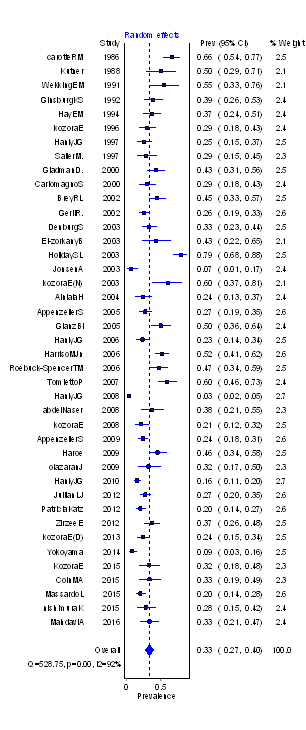Session Information
Session Type: ACR Poster Session A
Session Time: 9:00AM-11:00AM
Background/Purpose: To systematically review literature on: 1) the prevalence of Cognitive Impairment (CI) in SLE patients in the presence or absence of neuropsychiatric involvement (NPSLE), 2) the metrics of CI and 3) the relative risk (RR) for CI in SLE compared to Rheumatoid Arthritis (RA) and healthy individuals.
Methods: This review was prepared with a protocol following the Preferred Reporting Items for Systematic Reviews and Meta-Analysis-Protocols statement. Literature search (1900-2016) in Ovid Medline, Embase and Psyc INFO for articles on the prevalence of CI in adult SLE patients using a specified neuropsychological instrument of cognitive function (CF) was conducted. Included studies were critically appraised and analyzed. The prevalence of CI was studied for all instruments and whenever possible Pooled Prevalence (PP) was determined in the commonly used instruments [standardized batteries, Modified Mini–Mental State Exam (MMSE), Automated Neuropsychological Assessment Metric (ANAM) and Montreal Cognitive Assessment (MoCA)].
Results: Of 3422 references, 670 were selected for detailed review and 84 were included in the final analysis. Standardized batteries (including ACR battery) were utilized in 41 studies in 3338 patients and found a PP of CI of 34% (95% CI: 28-40%) (Figure 1). CI was higher in NPSLE with PP of 41 (95% CI: 26-57%) (Pooled from 13 studies in 647 NPSLE patients). ANAM was utilized in 9 studies in 773 patients and yielded a PP of CI of 37% (95% CI: 20-55%). MMSE was utilized in 9 studies in 766 patients and yielded a PP of CI of 19% (95% CI: 10-30%). MoCA was utilized in 2 studies in 100 patients and yielded a PP of CI of 45% (95% CI: 14-77%). A large variability in the prevalence of CI and a high statistical heterogeneity (I2> 75%) among studies was identified. This could have resulted because of: 1-the lack of standardization in the metrics and definitions of CI in SLE, 2) heterogeneity in the studied sample size (which involved patients with and without NPSLE) and 3) variability in other demographics such as patients age, education levels and others factors. The RR for CI in SLE was 1.77 (95% CI: 1.19-2.64) compared to RA (data from 6 studies of 343 lupus and 193 RA patients. The RR for CI in SLE compared to healthy individuals was 2.57 (95% CI: 1.62-4.08) (data from 10 studies of 529 SLE patients and 328 healthy individuals).
Conclusion: Patients with lupus have a high prevalence of CI ranging from 2.7–80% and largely depending on the metrics and the presence or absence of NPSLE. There is a lack of a standardized approach on how to measure and define CI in SLE. ANAM and standardized batteries (including ACR) yielded similar CI prevalence, while MMSE carried the lowest prevalence. NPSLE patients are as well at a higher risk for CI compared to non-NPSE. Lupus patients are at a higher risk to develop CI compared to RA and healthy individuals. Figure 1. Forest Plot of CI in SLE patients using standardized batteries including ACR
Figure 2. Forest Plot of CI in SLE patients using ANAM test:
To cite this abstract in AMA style:
Al Rayes H, Tani C, Mosca M, Medina-Rosas J, Moustafa A, Lambiris P, Touma Z. What Is the Prevalence of Cognitive Impairment in Lupus and Which Instruments Are Used to Measure It? a Systematic Review and Meta-Analysis [abstract]. Arthritis Rheumatol. 2016; 68 (suppl 10). https://acrabstracts.org/abstract/what-is-the-prevalence-of-cognitive-impairment-in-lupus-and-which-instruments-are-used-to-measure-it-a-systematic-review-and-meta-analysis/. Accessed .« Back to 2016 ACR/ARHP Annual Meeting
ACR Meeting Abstracts - https://acrabstracts.org/abstract/what-is-the-prevalence-of-cognitive-impairment-in-lupus-and-which-instruments-are-used-to-measure-it-a-systematic-review-and-meta-analysis/


